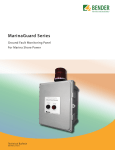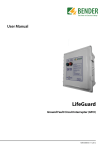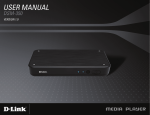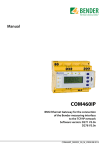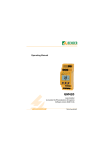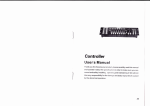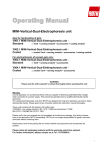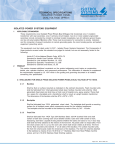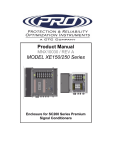Download MarinaGuard®
Transcript
TM User Manual MarinaGuard® Ground Fault Monitoring Panel For Marina Shore Power NAE1095810 / 03.2013 TM Bender Inc. USA: 700 Fox Chase Coatesville, PA 19320 Toll-Free: 800-356-4266 Phone: 610-383-9200 Fax: 610-383-7100 E-mail: [email protected] Canada: 5810 Ambler Drive, Unit 1 Mississauga, ON L4W 4J5 Toll-Free: 800-243-2438 Phone: 905-602-9990 Fax: 905-602-9960 E-mail: [email protected] Web: www.bender.org NAE1095810, 03.2013 © Bender Inc. All rights reserved. Content subject to change. Table of Contents 1. Introduction ..................................................................................................................... 5 1.1 1.2 MarinaGuard........................................................................................................................................ 5 Build Variations................................................................................................................................... 5 2. Safety Instructions............................................................................................................ 7 3. Preparation and Verification .......................................................................................... 9 3.1 3.1.1 3.1.2 Part Number Verification ................................................................................................................ 9 Model Numbers - MarinaGuard Panels...................................................................................... 9 Model Numbers - Current Transformers ................................................................................. 10 4. Installation, Connection, and Adjustments ............................................................... 11 4.1 4.2 4.2.1 4.2.2 4.2.3 4.2.4 4.2.5 4.3 4.3.1 4.3.2 4.3.3 4.4 4.4.1 4.4.2 4.4.3 4.4.4 4.4.5 Mounting ............................................................................................................................................ Panel Wiring....................................................................................................................................... Panel Wiring Diagram - MG-1...................................................................................................... Panel Wiring Diagram - MG-2...................................................................................................... Panel Wiring Diagram - MG-3...................................................................................................... Panel Wiring Diagram - MG-S...................................................................................................... Panel Wiring Diagram - MG-T...................................................................................................... Current Transformer Wiring......................................................................................................... Wiring to Panel - W1-S35 - W5-S210 Series ............................................................................ Wiring to Panel - W20 - W210 Series......................................................................................... Placement........................................................................................................................................... Field Adjustments............................................................................................................................ Field Adjustments - MG-1, MG-2, and MG-3 Panels ............................................................ Field Adjustments - MG-S Panels ............................................................................................... Field Adjustments - MG-T Panels ............................................................................................... Additional Setup Requirements for Communication Options........................................ Connecting MG-S or MG-T Panels to Modbus/TCP Gateway .......................................... 11 12 13 14 15 16 17 18 18 18 19 20 21 22 24 25 31 5. Operation ......................................................................................................................... 34 5.1 5.2 5.3 Front Panel Display ......................................................................................................................... 34 Apply Power to the Panel ............................................................................................................. 35 Procedure for Perfoming a Functional Test ........................................................................... 35 6. Troubleshooting ............................................................................................................. 36 MarinaGuard © 2013 Bender Inc. All Rights Reserved 3 6.1 6.2 6.3 6.3.1 6.3.2 6.4 4 Locating Ground Faults - MG-1, MG-2, MG-3 Panels .......................................................... Locating Ground Faults - MG-S, MG-T Panels ....................................................................... Error Codes ........................................................................................................................................ Error Codes: MG-1, MG-2, MG-3 ................................................................................................. Error Codes: MG-S, MG-T............................................................................................................... Ordering Information..................................................................................................................... © 2013 Bender Inc. All Rights Reserved 36 36 37 37 37 38 MarinaGuard Introduction 1. Introduction 1. 1 MarinaGuard MarinaGuard monitoring panels are designed to monitor feeder and/or branch circuits for shore power in marinas. When properly installed and initialized, these panels satisfy the requirements of NEC 555.3:2011, “Ground-Fault Protection.” Adjustable trip levels allow for setting the trip level lower than the required 100 mA if desired. External current transformers are used for measuring leakage current. All models come in a NEMA 4X enclosure suitable for outdoor use, as well as a strobe light externally mounted on the top of the enclosure for clear visual notification. Models may vary by option, refer to section 1.2 below for additional information. 1. 2 Build Variations MarinaGuard panels vary by available options. When installing and using the device, ensure that the correct directions are utilized based on the device purchased. Refer to section 3 of this manual for more information on variations between models. Possible variations include, but are not limited to: • Designed for feeder or branch monitoring • Quantity of monitors inside enclosure • Single-channel or multi-channel monitors inside enclosure • Supply voltage required to power panel • Modbus/TCP communication compatibility • SMS alarm messaging module MarinaGuard © 2013 Bender Inc. All Rights Reserved 5 Introduction This page left intentionally blank. 6 © 2013 Bender Inc. All Rights Reserved MarinaGuard Safety Instructions 2. Safety Instructions ! DANGER Hazard of Electric Shock, Burn, or Explosion Only qualified maintenance personnel shall operate or service this equipment. These instructions should not be viewed as sufficient for those who are not otherwise qualified to operate or service this equipment. This document is intended to provide accurate information only. No responsibility is assumed by BENDER for any consequences arising from use of this document. Turn OFF all sources of electrical power before performing any inspections, tests, or service on this equipment. Assume all circuits are live until they have been properly de-energized, tested, grounded, and tagged. Failure to do so will result in equipment damage, severe personal injury, or death. Proper operation of this equipment depends on proper installation. Neglecting fundamental installation techniques will result in equipment damage, severe personal injury, or death. Do not make any modifcations to this equipment. Failure to do so will result in equipment damage or personal injury. Only use manufacturer’s and manufacturer recommended accessories with this equipment. Failure to do so may damage the equipment beyond repair. The panel provides ground fault monitoring only. It does NOT provide short circuit or overload protection. MarinaGuard © 2013 Bender Inc. All Rights Reserved 7 Safety Instructions This page left intentionally blank. 8 © 2013 Bender Inc. All Rights Reserved MarinaGuard Preparation and Verification 3. Preparation and Verification 3. 1 Part Number Verification Refer to the tables in sections 3.1.1 and 3.1.2 for information on MarinaGuard models. Ensure that the correct panel has been selected for the application. Additionally, each feeder/branch monitored requires one BENDER current transformer. Ensure that the current transformer is large enough to have ALL conductors of the feeder/branch passing through it. For example, in a 240Y/120 VAC circuit, L1, L2, and the neutral must all pass through the current transformer. 3.1.1 Model Numbers - MarinaGuard Panels Quantity of Feeders / Branches Adjustable Trip Level Contact Outputs Supports Modbus/ TCP module Built-In SMS Alarm Module MG-1 1 10 mA - 10 A 1 individual No No MG-2 2 10 mA - 10 A 2 individual No No MG-3 3 10 mA - 10 A 3 individual No No MG-S 12 6 mA - 20 A 1 common Yes No MG-T 12 6 mA - 20 A 1 common, 12 individual Yes No MG-1C 1 10 mA - 10 A 1 individual No Yes MG-2C 2 10 mA - 10 A 2 individual No Yes MG-3C 3 10 mA - 10 A 3 individual No Yes MG-SC 12 6 mA - 20 A 1 common Yes Yes MG-TC 12 6 mA - 20 A 1 common, 12 individual Yes Yes Part Number MarinaGuard © 2013 Bender Inc. All Rights Reserved 9 Preparation and Verification 3.1.2 Model Numbers - Current Transformers Part Number Inside Diameter Color Terminal Type W1-S35 1.4” (35 mm) Black Screw Terminals W2-S70 2.75” (70 mm) Black Screw Terminals W3-S105 4.1” (105 mm) Black Screw Terminals W4-S140 5.5” (140 mm) Black Screw Terminals W5-S210 8.25” (210 mm) Black Screw Terminals W20 0.75” (20 mm) Yellow Cage Clamp W35 1.4” (35 mm) Yellow Cage Clamp W60 2.3” (60 mm) Yellow Cage Clamp W120 4.7” (120 mm) Yellow Cage Clamp W210 8.25” (210 mm) Yellow Cage Clamp 10 © 2013 Bender Inc. All Rights Reserved MarinaGuard Installation, Connection, and Adjustments 4. Installation, Connection, and Adjustments 4. 1 Mounting The standard enclosure for MarinaGuard panels is a NEMA 4X polycarbonate enclosure. The enclosure includes mounting feet and separate instructions on mounting the enclosure. Refer to these instructions for more information. Dimensions below are in inches (mm). The strobe light mounted to the top of the enclosure adds an additional 4.9” (125 mm) to the height of the enclosure listed below. Enclosure 12x10x6 MarinaGuard AxB 10.25” x 8.25” (260.5 x 209.5) © 2013 Bender Inc. All Rights Reserved C D E F G 12.75” (324) 10.75” (273) 13.4” (340) 7.7” (195.5) 12.3” (312.5) 11 Installation, Connection, and Adjustments 4. 2 Panel Wiring MarinaGuard panels utilize external current transformers for measurement. The only connections required inside the MarinaGuard panel itself are the connections to the current transformer(s) and 120 VAC control power for the internal circuitry. Contact output connections are only required when applicable. Placement of current transformers depends on the application as well as the MarinaGuard model utilized. Refer to page XX for more information. DANGER Turn off all sources of electrical power before installing this equipment. Observe all local, state and national codes, standards and regulations when installing this equipment. Failure to do so will result in equipment damage, severe personal injury, or death. Locate the correct wiring diagram in the table below. In general, the following steps must be observed: • 120 VAC control power must be brought into the panel and landed on the appropriate terminals to power the panel’s internal circuitry. • Some connections are made to backplate-mounted connection terminals. Others are made directly to the respective ground fault monitor. Observe these connections carefully on the respective wiring diagram. • Placement of current transformer varies by model and application. Refer to page XX for information on example placement locations. Wiring Diagram Current Transformer Instructions Field Adjustment Instructions “C” Option Instructions (SMS) MG-1 page 13 page 18 page 21 page 25 MG-2 page 14 page 18 page 21 page 25 MG-3 page 15 page 18 page 21 page 25 MG-S page 16 page 18 page 22 page 25 MG-T page 17 page 18 page 22 page 25 Part Number Refer to section 4.5 for additional instructions required for setting up the following communication options: • Additional setup instructions for using the built-in SMS alarm notification (“C” option) • 12 Instructions for connecting MG-S or MG-T panels to the COM460IP Modbus/TCP module © 2013 Bender Inc. All Rights Reserved MarinaGuard Installation, Connection, and Adjustments 4.2.1 Panel Wiring Diagram - MG-1 Cust. Connection 120 VAC Aux Supply N L Cust. Connection GROUND 120 VAC N/O For External Alarm L N 123 4 External Current Transformer Monitoring Feeder / Branch To External 120VAC N/O Alarm, Contactor, Shunt Trip, Etc. Connection Notes: • Landing terminals are provided for external 120 VAC alarm and input 120 VAC control power (HOT only). Neutral (0V) of control power is wired directly into the black labeled RCM470LY monitor at terminal A2. • The alarm output landing terminals are set to NORMALLY OPEN operation and supplied with 120 VAC when closed. Output connection for this alarm relay is optional and may be connected to additional remote notification, or interruption means such as a shunt trip breaker. • Current transformer connections k and l are wired DIRECTLY into the RCM470LY monitor. No additional landing terminals are provided. • Qty. 1, 2 ampere, 250 V, type 3AG fuse is included. MarinaGuard © 2013 Bender Inc. All Rights Reserved 13 Installation, Connection, and Adjustments 4.2.2 Panel Wiring Diagram - MG-2 Cust. Connection 120 VAC Aux Supply N L Cust. Connection GROUND 120 VAC N/O Output Monitor 1 L N Repeat for Monitor 2 L N L N 123 4 External Current Transformer Monitoring Feeder / Branch 120 VAC N/O 120 VAC N/O Output Common Monitor 2 Output To External To External To External 120 VAC N/O 120 VAC N/O 120 VAC N/O Feeder 2 Feeder 2 Common Alarm / Shunt Alarm / Shunt Alarm Connection Notes: • Landing terminals are provided for external 120 VAC alarm and input 120 VAC control power (HOT only). Neutral (0V) of control power is wired directly into the black labeled RCM470LY monitor at terminal A2. 14 • The alarm output landing terminals are set to NORMALLY OPEN operation and supplied with 120 VAC when closed. Output connection for this alarm relay is optional and may be connected to additional remote notification, or interruption means such as a shunt trip breaker. • One common alarm output is provided, along with individual outputs for each monitor. • Current transformer connections k and l are wired DIRECTLY into the RCM470LY monitor. No additional landing terminals are provided. The wiring diagram above only shows one current transformer connection for reference purposes. Repeat for each additional monitor. • Qty. 1, 2 ampere, 250 V, type 3AG fuse is included. © 2013 Bender Inc. All Rights Reserved MarinaGuard Installation, Connection, and Adjustments 4.2.3 Panel Wiring Diagram - MG-3 Cust. Connection 120 VAC Aux Supply N L Cust. Connection GROUND 120 VAC N/O Output Monitor 1 120 VAC N/O Output Monitor 2 L N L N 120 VAC N/O 120 VAC N/O Output Common Monitor 3 Output 123 4 External Current Transformer Monitoring Feeder / Branch L N L N Repeat for Monitor 2 and Monitor 3 To External To External To External To External 120 VAC N/O 120 VAC N/O 120 VAC N/O 120 VAC N/O Feeder 2 Feeder 2 Common Feeder 2 Alarm Alarm / Shunt Alarm / Shunt Alarm / Shunt Connection Notes: • Landing terminals are provided for external 120 VAC alarm and input 120 VAC control power (HOT only). Neutral (0V) of control power is wired directly into the black labeled RCM470LY monitor at terminal A2. • The alarm output landing terminals are set to NORMALLY OPEN operation and supplied with 120 VAC when closed. Output connection for this alarm relay is optional and may be connected to additional remote notification, or interruption means such as a shunt trip breaker. • One common alarm output is provided, along with individual outputs for each monitor. • Current transformer connections k and l are wired DIRECTLY into the RCM470LY monitor. No additional landing terminals are provided. The wiring diagram above only shows one current transformer connection for reference purposes. Repeat for each additional monitor. • Qty. 1, 2 ampere, 250 V, type 3AG fuse is included. MarinaGuard © 2013 Bender Inc. All Rights Reserved 15 Installation, Connection, and Adjustments 4.2.4 Panel Wiring Diagram - MG-S Cust. Connection 120 VAC Aux Supply N L Cust. Connection GROUND l - Row Current Transformer 1/2 5/6 9/10 3/4 7/8 11/12 k- Row Current Transformer 120 VAC N/O For External Alarm 1 2 3 4 5 6 7 8 9 10 11 12 L N 123 4 External Current Transformer(s) Monitoring Feeder(s) / Branch(es) Repeat For All Channels To External 120VAC N/O Alarm, Contactor, Shunt Trip, Etc. Connection Notes: • Landing terminals are provided for external 120 VAC alarm and input 120 VAC control power (HOT only). Neutral (0V) of control power is wired directly into the black labeled RCMS460 monitor at terminal A2. 16 • The alarm output landing terminals are set to NORMALLY OPEN operation and supplied with 120 VAC when closed. Output connections for this alarm relay are optional and may be connected to additional remote notification, or interruption means such as a shunt trip breaker. • Up to twelve (12) feeders or branches may be monitored by a single MG-S panel. Each branch requires one current transformer. Landing terminals are provided for current transformer connections. Ensure that each is connected to the correct terminals. For example, current transformer 1 is connected to “lrow” terminal “1/2” and “k-row” terminal 1. “l-row” terminals are shared between two sequential current transformers. • Refer to page 22 for adjustment instructions, as well as for instructions on disabling unused channels. • Qty. 1, 2 ampere, 250 V, type 3AG fuse is included. © 2013 Bender Inc. All Rights Reserved MarinaGuard Installation, Connection, and Adjustments 4.2.5 Panel Wiring Diagram - MG-T Cust. Connection 120 VAC Aux Supply N L Cust. Connection GROUND k- Row Current Transformer Individual Dry N/O outputs 9/10 7/8 11/12 1 2 3 4 5 6 7 8 9 10 11 12 L (120V) Customer Supplied 3 4 5 6 7 8 9 10 11 12 L (120V) Customer Supplied 123 4 External Current Transformer(s) Monitoring Feeder(s) / Branch(es) 2 COM. N/O COM. N/O COM. N/O 5/6 3/4 COM. N/O 1 1/2 COM. N/O COM. N/O COM. N/O COM. N/O COM. N/O COM. N/O COM. N/O COM. N/O l - Row Current Transformer Repeat For All Channels Dry Contact Output, to N/O Alarm, Shunt Trip, Etc. Repeat For Other Branches Connection Notes: • Landing terminals are provided for external 120 VAC alarm and input 120 VAC control power (HOT only). Neutral (0V) of control power is wired directly into the black labeled RCMS490 monitor at terminal A2. • The alarm output landing terminals are set to NORMALLY OPEN operation and are dry. Contacts must be externally supplied by the hot conductor (L) of 120 VAC. Only one output connection is shown, repeat for all other used channels. Output connections for this alarm relay are optional and may be connected to additional remote notification, or interruption means such as a shunt trip breaker. • Up to twelve (12) feeders or branches may be monitored by a single MG-T panel. Each branch requires one current transformer. Landing terminals are provided for current transformer connections. Ensure that each is connected to the correct terminals. For example, current transformer 1 is connected to “lrow” terminal “1/2” and “k-row” terminal 1. “l-row” terminals are shared between two sequential current transformers. • Refer to page 22 for adjustment instructions, as well as for instructions on disabling unused channels. • Qty. 1, 2 ampere, 250 V, type 3AG fuse is included. MarinaGuard © 2013 Bender Inc. All Rights Reserved 17 Installation, Connection, and Adjustments 4. 3 Current Transformer Wiring Refer to page 10 to determine the type of current transformer(s) utilized, as well as the appropriate wiring diagram to determine how to connect the current transformer(s) to the panel. 4.3.1 Wiring to Panel - W1-S35 - W5-S210 Series This section applies to the following current transformers: W1-S35, W2-S70, W3-S105, W4-S140, W5-S210. These current transformers are black in color. Standard screw terminals are used to connect wires. Use AWG 22, shielded cable. The maximum length is 130 ft (40 m). 4.3.2 Wiring to Panel - W20 - W210 Series This section applies to the following current transformers: W20, W35, W60, W120, W210. These current transformers are yellow in color. Cage clamp type terminals are used to connect wires. Use AWG 22, shielded cable. The maximum length is 130 ft (40 m). Follow the steps below to connect wiring: • A black cover above the terminals covers the opening tabs. Open this cover to the right. 18 • Using a flathead screwdriver, press down on the tab above the desired screw terminal. This will open the terminal below it. • While holding in the tab, place the wire into the open terminal. • Remove the flathead screwdriver from the tab to close the terminal. © 2013 Bender Inc. All Rights Reserved MarinaGuard Installation, Connection, and Adjustments 4.3.3 Placement Placement of current transformers varies by model and application. In general, MG-1, MG-2, and MG-3 panels are used for monitoring main feeders, while MG-S and MG-T models are used for monitoring individual branches. The diagram below shows typical locations of current transformers. Use of these models may vary - consult the manufacturer for more information. DANGER Turn off all sources of electrical power before installing this equipment. Observe all local, state and national codes, standards and regulations when installing this equipment. Failure to do so will result in equipment damage, severe personal injury, or death. When placing current transformers around system conductors, ensure all conductors, including the neutral if it is being used, are placed through the single current transformer. For example, in a 240Y/120 VAC circuit, L1, L2, and N are all placed through the current transformer. The ground conductor is NOT passed through the current transformer. Conductors shall be passed through centrally and at a right angle through the current transformer. 240/120V Grounded Neutral Supply Transformer Current Transformer (CT) Position 1 Primary Main Circuit Breaker Current Transformer (CT) Position 2 Power Distribution Main Circuit Breaker Branch Circuit Breakers Strobe ON indicates Ground Fault Ground Fault Monitor Monitor ON Fault Alarm Push to Test Push to Reset Support: 800-356-4266 Current Transformer (CT) Position 3 Shore Power Pedestal Receptacle Circuit Breaker Receptacle MarinaGuard © 2013 Bender Inc. All Rights Reserved 19 Installation, Connection, and Adjustments 4. 4 Field Adjustments Adjustable options vary by model. Options shown in section 3.1 determine which are available. Refer to the table below for the section on how to adjust any available options, Part Number 20 Refer To MG-1 page 21 MG-2 page 21 MG-3 page 21 MG-S pages 22-23 MG-T pages 22-24 © 2013 Bender Inc. All Rights Reserved MarinaGuard Installation, Connection, and Adjustments 4.4.1 Field Adjustments - MG-1, MG-2, and MG-3 Panels MG-1, MG-2, and MG-3 panels utilize the RCM470LY-13 or equivalent ground fault monitor. These models allow for adjustment of the trip level steplessly from 10 mA to 10 A. An adjustable time delay is also available, from 0 to 10 seconds. These models are typically used for monitoring main feeders for ground fault currents of 100 mA or less. NEC 555.3:2011 requires a trip level no higher than 100 mA, however a lower alarm level is recommended whenever possible. The factory default setting is 100 mA. All adjustments are made using the DIP switches and potentiometers on the face of the monitor. Open the enclosure to view the ground fault monitor and follow the instructions below to make any necessary adjustments. DO NOT CHANGE THE FIRST TWO DIP SWITCHES FROM THE LEFT. These are essential for proper operation of the panel and shall not be modified. Alarm response range 10 - 100 mA 30 - 300 mA 100 - 1000 mA 300 - 3000 mA 500 - 5000 mA 1 - 10 A Time delay multiplier • Only one (or none) of the numbered DIP switches shall be active (down) at any time. This functions as the “starting point” for the desired trip level. Once active, use the potentiometer “x mA” to act as a mutiplier of this value, from x1 to x10. • For example, to use a trip level of 50 mA, press the “10” DIP switch down, and the remaining numbered DIP switches up. Turn the potentiometer “x mA” halfway to 5. • Use the potentiometer “t/s” to adjust the trip level between 0 and 1 second. Use the last DIP switch on the right to multiply this value by 10 if desired. For example, for a time delay of 5 seconds, adjust the “t/s” potentiometer halfway to 0.5, and press the last DIP switch down to x10. • For MG-2 and MG-3 panels, repeat the above steps for the other monitors to set the desired trip level and time delay for other monitored feeders. MarinaGuard © 2013 Bender Inc. All Rights Reserved 21 Installation, Connection, and Adjustments 4.4.2 Field Adjustments - MG-S Panels MG-S series panels use the RCMS460-D-2 multi-channel ground fault monitor. Up to twelve (12) separate branches may be monitored. Individual alarm trip points may be set for each branch based on typical measured levels. Typically, these models are used for monitoring either multiple main feeders, or individual branches at low-mA levels. The main screen shows a bar graph indicating the status of each branch, from 0 to 100% of the respective alarm level. All adjustments are made using the four blue pushbuttons and the digital display. Open the enclosure to view the ground fault monitor and follow the instructions below to make any necessary adjustments. DO NOT CHANGE ANY SETTINGS OTHER THAN THOSE LISTED BELOW. These are essential for proper operation of the panel and shall not be modified. Step 1 (Required): Set Device as Master This step must be completed when a single MG-S panel is used, or when panels are NOT connected together via RS-485 to avoid a “No Master” error message that may appear. If multiple panels are connected together via RS-485 to go to the COM460IP Modbus/TCP gateway, do not complete this step. Instead, refer to section 4.5.2. 1 Press the MENU button. 2 Press the DOWN button until “Settings” is reached. Press the MENU button. 3 Press the DOWN button until “Interface” is reached. Press the MENU button. 4 Press the MENU button. Press the UP button to change the number to one, and press the MENU button to confirm. 5 Press the ESC button several times until the menu is exited. Step 2 (Required): Disable Unused Channels By default, all twelve channels are active. Active channels with no connected current transformer will activate the CT connection alarm. This step is required to avoid any connection error messages that may appear from unused channels. 1 Press the MENU button. 2 Press the DOWN button until “Channel” is reached. Press the MENU button. 3 Press the UP button so that the numbers at the top of the screen are flashing. Press the MENU button. 4 Press the UP or DOWN button until the numbers reach “1...12.” Press the MENU button. Any settings changed now with affect ALL channels. 5 Press the DOWN button until “CT” is reached. Press the MENU button. 6 Press the DOWN button to change this to “OFF.” Press the MENU button to confirm. 7 Press the UP button until the numbers at the top of the screen area reached again. 8 Press the MENU button. Press the UP button to change this value to “1.” Press the MENU button to confirm. All settings changes now will only affect channel 1. 9 Press the DOWN button until “CT” is reached. Press the MENU button. 10 Press the DOWN button to change this to “TYPE A.” Press the MENU button to confirm. 11 Repeat steps 7 through 10 for all other channels used. Stop when unused channels are reached. 22 © 2013 Bender Inc. All Rights Reserved MarinaGuard Installation, Connection, and Adjustments Step 3: Adjust Alarm Trip Level 1 Press the MENU button. 2 Press the DOWN button until “Channel” is reached. Press the MENU button. 3 Press the UP button so that the numbers at the top of the screen are flashing. Press the MENU button. 4 Press the UP or DOWN button to reach the desired branch(es) that will be changed. To change the trip level for all channels, change this to “1...12.” Otherwise, choose the number that corresponds to the desired branch. Press the MENU button to confirm. 5 Press the DOWN button until “RESP. VALUE” is reached. Press the MENU button. 6 Press the UP or DOWN buttons until the desired alarm level is reached. Press the MENU button to confirm. 7 Repeat steps 4 through 6 for any other desired branches. Step 4: Adjust Time Delay 1 Press the MENU button. 2 Press the DOWN button until “Channel” is reached. Press the MENU button. 3 Press the UP button so that the numbers at the top of the screen are flashing. Press the MENU button. 4 Press the UP or DOWN button to reach the desired branch(es) that will be changed. To change the trip level for all channels, change this to “1...12.” Otherwise, choose the number that corresponds to the desired branch. Press the MENU button to confirm. 5 Press the DOWN button until “T(on)” is reached. Press the MENU button. 6 Press the UP or DOWN buttons until the desired time delay is reached. Press the MENU button to confirm. 7 Repeat steps 4 through 6 for any other desired branches. MarinaGuard © 2013 Bender Inc. All Rights Reserved 23 Installation, Connection, and Adjustments 4.4.3 Field Adjustments - MG-T Panels MG-T series panel use the RCMS490-D-2 multi-channel ground fault monitor. The RCMS490-D-2 has all of the same features as the RCMS460-D-2 listed in section 4.4.2, additionally with individual contact outputs for each branch. All adjustments are made using the four blue pushbuttons and the digital display. Open the enclosure to view the ground fault monitor and follow the instructions below to make any necessary adjustments. DO NOT CHANGE ANY SETTINGS OTHER THAN THOSE LISTED BELOW. These are essential for proper operation of the panel and shall not be modified. Follow Steps 1 through 4 as noted in Section 4.4.2 for MG-S panels. All steps remain the same. Additionally, follow step 5 below if necessary. Step 5: Set Individual Contacts to N/O or N/C By default, the individual contact outputs are set to normally open / normally de-energized (N/O) operation. Follow the steps below to set the contacts to normally closed / normally energized (N/C) operation. 1 Press the MENU button. 2 Press the DOWN button until “Channel” is reached. Press the MENU button. 3 Press the UP button so that the numbers at the top of the screen are flashing. Press the MENU button. 4 Press the UP or DOWN button to reach the desired branch(es) that will be changed. To change the trip level for all channels, change this to “1...12.” Otherwise, choose the number that corresponds to the desired branch. Press the MENU button to confirm. 5 Press the DOWN button until “OP-Mode” is reached. Press the MENU button. 6 Press the UP or DOWN button until the desired setting is reached. Refer to the table below for information on available settings. 7 Repeat steps 4 through 6 for any other desired branches. Setting 24 Description N/O Normally open / normally de-energized operation N/O-T Normally open / normally de-energized operation, trips during self-test N/C Normally closed / normally energized operation N/C-T Normally closed / normally energized operation, trips during self-test © 2013 Bender Inc. All Rights Reserved MarinaGuard Installation, Connection, and Adjustments 4. 5 4.5.1 Additional Setup Requirements for Communication Options Built-In SMS Alarm Notification (“C” Option) Panels with option “C” feature an SMS alarm messaging module which will send a text message to a cell phone if the MarinaGuard goes into alarm. This module is compatible with any type MarinaGuard panel. The modules is mounted to the inside of the door. Modules include a PLC for control as well as a GSM module for sending SMS messages. The GSM module connects to a low profile antenna, mounted to the bottom of the enclosure. Additional documentation has been supplied with the panel for setting up the SIM card and the module to full functionality. Refer to these documents for more detailed information. General steps for setting up the SMS messaging begin on the following page. For reference, model number MG-1C is shown below (drawing not to scale). MarinaGuard © 2013 Bender Inc. All Rights Reserved 25 Installation, Connection, and Adjustments Step 1: Activate SIM Card A SIM card must be purchased and activated with an SMS messaging plan. Refer to the additionally included document for information on purchasing and activating a SIM card. Additional fees for SMS service may apply. Once activated, the service provider will provide documentation with provisioning information required for step 3 below. For more information, refer to the separately enclosed documentation. SMS service is not provided by BENDER. SMS messaging providers are not affiliated with BENDER or its subsidiaries. Insert the SIM card into the SIM card slot located on the top of the GSM module, as shown below. Step 2: Install PLC Management Software The included PLC management software must be installed on a Windows PC that can connect to the PLC via USB. This is required in order to set up the SIM card information as well as the phone contact information that will receive the SMS alerts. Run the installation file for the nano Navigation Software and follow the instructions to install the program. Once the software is sucessfully installed, open the program. Step 3: Enter SIM card and Phone Contact Information SIM card information (provided by the SMS service provider) as well as contact information for the receiver of SMS alerts must be entered into the PLC. Follow the instructions on the following pages to make these settings changes. DO NOT CHANGE ANY OTHER SETTINGS OTHER THAN THOSE SHOWN IN THIS STEP. Failure to do so will render the PLC inoperable. 26 © 2013 Bender Inc. All Rights Reserved MarinaGuard Installation, Connection, and Adjustments Steps for SIM Card Settings 1 Open the included file “Marina Guard PLC.nano.” 2 Click on “nanoLC” then click on “Configuration...” MarinaGuard © 2013 Bender Inc. All Rights Reserved 27 Installation, Connection, and Adjustments 28 3 A configuration screen will appear as shown below. 4 Click on the “Configure...” button circled above. The configuration window shown below will appear. Enter in the SIM card PIN number and the Station ID into the available text boxes. These numbers will be provided by the SMS service provider after activating the SIM card. © 2013 Bender Inc. All Rights Reserved MarinaGuard Installation, Connection, and Adjustments 5 Once completed, click on the “Telephone Book” tab. The configuration window will change as shown below. Enter in the phone number that will receive the SMS alerts, the description (typically the name of the technician), and check the checkboxes “SMS Permit,” “SMS Confirm,” “Project Msg Notify,” and “Fault Notify.” If more than one phone number will receive SMS alerts, repeat this step on additional lines. 6 Once completed, click OK to confirm settings changes and to return to the main configuration screen. Click OK again to confirm and return to the main software screen. Keep the “Marina Guard PLC.nano” file open and do not exit the program. 7 Connect the computer to the PLC’s USB port as shown in the figure below. Use Type A-B USB cable (commonly referred to as a “printer USB cable”) for connecting. MarinaGuard © 2013 Bender Inc. All Rights Reserved 29 Installation, Connection, and Adjustments 8 Click on “nanoLC” then click on “Download” as shown below. 9 The software will download the updates to the PLC. The program will display a notification window when the download has completed. If any error messages appear, check that the PLC is properly connected and check for any possible COM port conflicts. 10 Disconnect the PLC from the PC. Perform a Commissioning Test on the SMS Notification Perform an initial test of the system once the SMS notification has been properly set up. Push the TEST button on the front of the MarinaGuard panel. The PLC display will show “Test” followed by “Fault in the System.” These messages will also be sent to the phone number that was entered. PLC display during normal operation 30 PLC display after pushing the TEST button PLC display showing test fault message © 2013 Bender Inc. All Rights Reserved MarinaGuard Installation, Connection, and Adjustments 4.5.2 Connecting MG-S or MG-T Panels to Modbus/TCP Gateway MG-S and MG-T panels support connecting to BENDER’s COM460IP communication module. The COM460IP provides a GUI interface for managing BENDER devices across a standard Ethernet network, as well as functioning as a Modbus/TCP gateway. Connection between panels is made using a two-wire RS-485 connection (standard RS-485 limitations apply). Follow the below steps to wire and setup the communication system. Refer to COM460IP user manual for more detailed information on installation, setup, and use of the commmunication gateway. Step 1: Wiring A two-wire RS-485 connection is required across all MarinaGuard panels and the COM460IP. Connections are made at each device’s A and B terminals. Connections are made in a daisy chain formation and made directly to the A and B terminals on the internal RCMS460 / RCMS490 monitor. Refer to the diagram below. A termination resistor DIP switch must be activated at the devices at the beginning and end of the chain. Devices in the middle will have this switch set to OFF. RS-485 Termination off on R MG-S / MG-T Panel 1 Internal RCMS Monitor RS-485 Termination off on R MG-S / MG-T Panel 2 Internal RCMS Monitor RS-485 Termination RS-485 Termination off off on on R R MG-S / MG-T Panel 3 Internal RCMS Monitor COM460IP . . . The maximum total length of the RS-485 with no repeater is 3900 ft (1200 m). For greater distances, an RS-485 repeater is required (BENDER part number DI-1DL). Step 2: Set RS-485 Addressing The RS-485 bus operates on a master/slave principle. Each device on the RS-485 communication bus requires a unique, sequential address. Set the COM460IP to address 1 to set it as the master. Refer to COM460IP user manual for information on setting the RS-485 address. For the remainder MG-S/MG-T panels, open the enclosure to view the RCMS460 / RCMS490 inside. Beginning with number 2, set the RCMS in each panel to a unique, sequential address. Follow the steps below: 1 Press the MENU button. 2 Press the DOWN button until “Settings” is reached. Press the MENU button. 3 Press the DOWN button until “Interface” is reached. Press the MENU button. 4 Press the MENU button. Press the UP button to change the number to the desired address, and press the MENU button to confirm. 5 Press the ESC button several times until the menu is exited. 6 Repeat these steps for each panel, incrementing the address each time. MarinaGuard © 2013 Bender Inc. All Rights Reserved 31 Installation, Connection, and Adjustments Step 3: Set Up Interfacing The COM460IP may be used as an interface for managing BENDER devices across a standard Ethernet network, or it may be used as a gateway to a Modbus/TCP network. Connecting to a Modbus/TCP Network The COM460IP acts as a gateway between BENDER’s RS-485 network and a Modbus/TCP network. The COM460IP acts as a slave on a Modbus/TCP network. Data is queried from a Modbus/TCP master to the COM460IP, which then retrieves data from the BENDER RS-485 network. Connect the COM460IP to the Modbus/TCP network using one of the available Ethernet ports. Refer to COM460IP user manual for detailed information on utilizing the Modbus/TCP function, including setup and relevant registers for RCMS460 / RCMS490 devices. Connecting to an Ethernet Network Connect the COM460IP to a network using one of the available Ethernet ports. If connecting to a network which supports DHCP, the COM460IP will automatically aquire an IP address. Otherwise, IP addressing will need to be manually set. Once completed, any computer on the network may connect to the GUI by opening a web browser and typing in the IP address of the COM460IP (Silverlight plugin is required). Once accessed, all devices connected on the RS-485 network may be managed. Note that MG-S panels will appear in the list as RCMS460, and MG-T panels will appear in the list as RCMS490. Refer to COM460IP user manual for more detailed information on using the user interface. Refer to the following page for interface samples. Note that the BENDER communication bus is not limited to MarinaGuard panels - other BENDER devices may connect to the network and be managed at the COM460IP interface. 32 © 2013 Bender Inc. All Rights Reserved MarinaGuard Installation, Connection, and Adjustments Below is a sample of the standard interface showing the status of a device. Below is a sample of the COM460IP Option D, allowing for the visualization of the network and status of BENDER connected devices: MarinaGuard © 2013 Bender Inc. All Rights Reserved 33 Operation 5. Operation 5. 1 Front Panel Display The example shown below is applicable to the MG-1, MG-S, and MG-T. See notes. below for MG-2 and MG-3. 3 Strobe ON indicates Ground Fault Ground Fault Monitor Monitor ON Fault Alarm Push to Test Push to Reset 2 1 Support: 800-356-4266 34 1 POWER light / TEST button: Illuminates green when the panel has received power and has not tripped. Holding the button for at least 2 seconds initiates a self-test of the monitor. 2 TRIPPED light / TEST button: Illuminates red when the panel is in alarm. A momuntary push of the button will reset the panel if the fault has been cleared. 3 Strobe Light: Provides visual indication of an alarm state in addition to the red TRIPPED light. • MG-2 and MG-3 panels will have one set of pushbuttons / lights for each monitor (two sets total for MG2, three sets total for MG-3). Regardless of type, there is one common strobe light. • MG-S and MG-T panels will have one set only, common to all channels. Pushing the RESET button will reset all channels which are in alarm and with faults cleared. For MG-T panels, pressing the TEST button will switch any branch contacts that are set to N/O-T or N/C-T operation. © 2013 Bender Inc. All Rights Reserved MarinaGuard Operation 5. 2 Apply Power to the Panel To apply power, close the circuit breaker / disconnect to the 120 VAC control power entering the panel. The panel will immediately power on. If there are no ground faults present on the load side, the green power ON light will illuminate. 5. 3 Procedure for Perfoming a Functional Test Follow the steps below to perform a functional test: • Press and hold the TEST button for at least two (2) seconds. The red “Fault Alarm” light will illuminate and the strobe light will activate. The green power ON light will no longer illuminate. • Momuntarily press the RESET button. If there are no faults on the system, the red “Fault Alarm” light and the strobe light will clear and the green power ON light will illuminate. For MG-2 and MG-3 panels, repeat these steps for the other monitors. For MG-T, note that only contact outputs set to “N/O-T “ or “N/C-T” will trip when the self-test is activated. MarinaGuard © 2013 Bender Inc. All Rights Reserved 35 Troubleshooting 6. Troubleshooting 6. 1 Locating Ground Faults - MG-1, MG-2, MG-3 Panels If a MarinaGuard panel has gone into alarm, use the monitor that is in alarm to locate the corresponding feeder with the ground fault. Several recommended options are available for locating faults: • Shut off individual branch breakers one at a time, until pressing the RESET button on the front of the panel resets the system back to the normal condition. If this occurs, the branch that was just shut off is causing the alarm condition. • Use a low-mA, clamp-on ammeter. Clamp around each individual shore cord. Ensure that all conductors EXCEPT the ground conductor are inside the clamp when taking a measurement. This method is used to measure actual leakage current in a similar fashion to the measurement taken by the MarinaGuard panel. Use this method to locate the individual branch causing the fault. This method is also desirable where there may be more than one branch adding to the total leakage current measurement at the feeder. 6. 2 Locating Ground Faults - MG-S, MG-T Panels If MG-S and MG-T panels are used for branch monitoring, fault location will be done automatically. The enclosed ground fault monitor will indicate which branch(es) have the fault. The screen will also display how much leakage current was detected. Events that occur are also stored with timestamp in the device’s internal history memory. Open the enclosure and view the monitor. The detected alarms should automatically display on the the screen, with the channel number. If more than one branch has fault current, the screen will cycle between the different alarms. ALARM 1/1 Residual current 130 mA Addr.: 2 Chan.: 12 ( To cycle through the history memory to view timestamped alarms, follow the steps below: • Press the MENU button to enter the main menu. • Press the DOWN button until “History” is reached. Press the MENU button. • Press the UP and DOWN buttons to scroll through the timestamped alarm events. Additionally, if MG-T panels have the individual contacts connected to means of interruption on the individual branches, such as shunt trip breakers, the channel(s) in the alarm state will have power interrupted to the affected circuit(s). 36 © 2013 Bender Inc. All Rights Reserved MarinaGuard Troubleshooting 6. 3 Error Codes Error codes are displayed on the ground fault module located inside the enclosure. 6.3.1 Error Codes: MG-1, MG-2, MG-3 Blinking Alarm LED 6.3.2 Connection error: No current transformer or bad CT connection Action: Check connections “k” and “l” between ground fault module and current transformer. Check connections for short circuit or open circuit. The panel must be manually reset after clearing this error. Error Codes: MG-S, MG-T Error codes may be specific to a branch or to the entire device. Messages will be displayed with “Fault” at the top left hand corner. MarinaGuard CT Connection Connector error: No current transformer or bad CT connection This error may be specific to one or more channels. Action: Check current transformer connections for open circuit. The panel must be manually reset after clearing this error. Device Error 71 RS-485 error: No master detected Action: Ensure that Step 1 in Section 4.4.2 (Set device as master) has been completed if no other devices are connected. If other devices are connected, check RS-485 connections. Verify that the device set as the master is properly connected. The panel must be manually reset after clearing this error. Device Error 72 RS-485 connection error Action: Check all RS-485 connections. The panel must be manually reset after clearing this error. All other errors Contact the manufacturer. © 2013 Bender Inc. All Rights Reserved 37 Troubleshooting 6. 4 Ordering Information Refer to Section 3.1.1, “Model Numbers - MarinaGuard Panels” for ordering information. 38 © 2013 Bender Inc. All Rights Reserved MarinaGuard TM Bender Inc. USA: 700 Fox Chase Coatesville, PA 19320 Toll-Free: 800-356-4266 Phone: 610-383-9200 Fax: 610-383-7100 E-mail: [email protected] Canada: 5810 Ambler Drive, Unit 1 Mississauga, ON L4W 4J5 Toll-Free: 800-243-2438 Phone: 905-602-9990 Fax: 905-602-9960 E-mail: [email protected] Web: www.bender.org








































